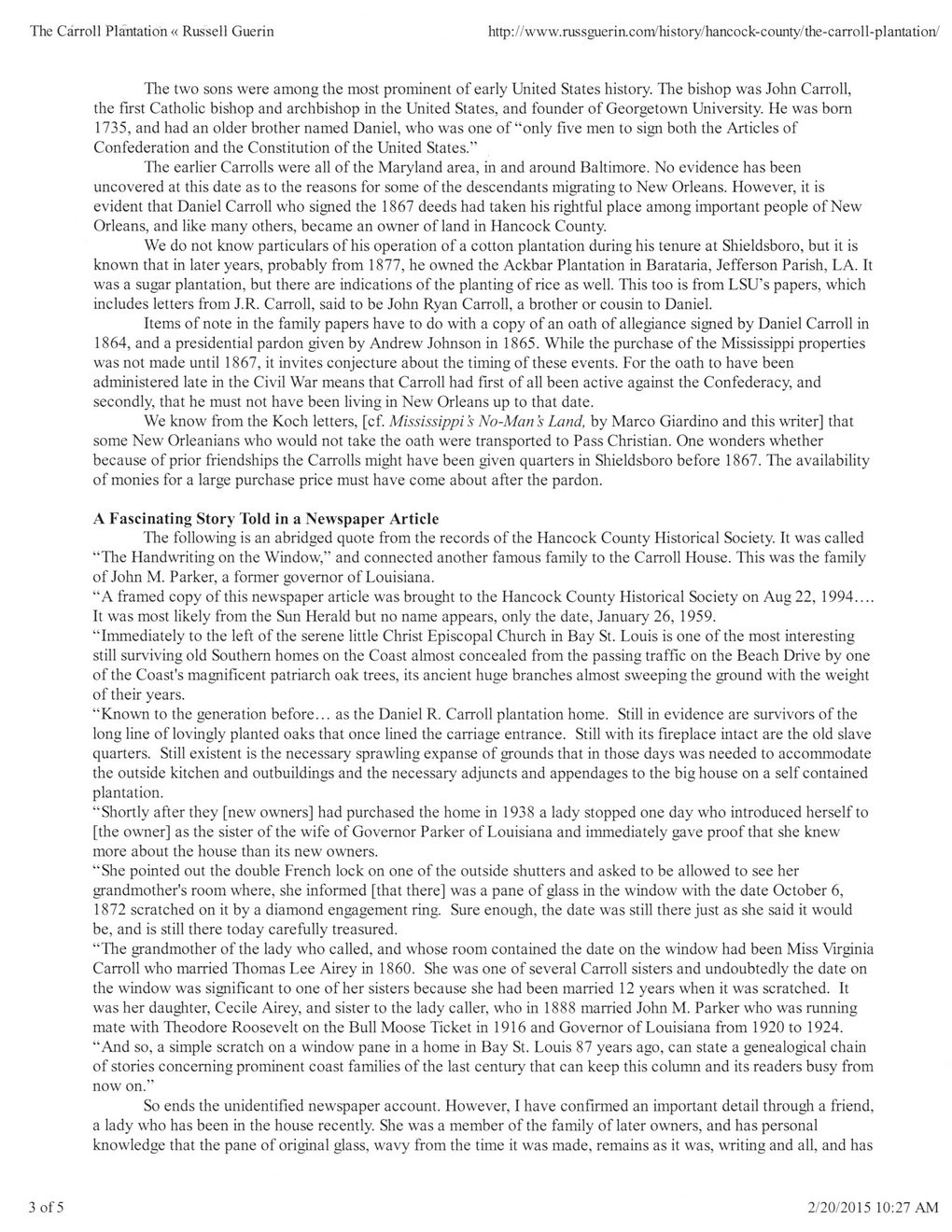This text was obtained via automated optical character recognition.
It has not been edited and may therefore contain several errors.
The Carroll Plantation « Russell Guerin http://www.russguerin.com/history/hancock-county/the-carroll-plantation/ The two sons were among the most prominent of early United States history. The bishop was John Carroll, the first Catholic bishop and archbishop in the United States, and founder of Georgetown University. He was bom 1735, and had an older brother named Daniel, who was one of “only five men to sign both the Articles of Confederation and the Constitution of the United States.” The earlier Carrolls were all of the Maryland area, in and around Baltimore. No evidence has been uncovered at this date as to the reasons for some of the descendants migrating to New Orleans. However, it is evident that Daniel Carroll who signed the 1867 deeds had taken his rightful place among important people of New Orleans, and like many others, became an owner of land in Hancock County. We do not know particulars of his operation of a cotton plantation during his tenure at Shieldsboro, but it is known that in later years, probably from 1877, he owned the Ackbar Plantation in Barataria, Jefferson Parish, LA. It was a sugar plantation, but there are indications of the planting of rice as well. This too is from LSU’s papers, which includes letters from J.R. Carroll, said to be John Ryan Carroll, a brother or cousin to Daniel. Items of note in the family papers have to do with a copy of an oath of allegiance signed by Daniel Carroll in 1864, and a presidential pardon given by Andrew Johnson in 1865. While the purchase of the Mississippi properties was not made until 1867, it invites conjecture about the timing of these events. For the oath to have been administered late in the Civil War means that Carroll had first of all been active against the Confederacy, and secondly, that he must not have been living in New Orleans up to that date. We know from the Koch letters, [cf. Mississippi’s No-Man s Land, by Marco Giardino and this writer] that some New Orleanians who would not take the oath were transported to Pass Christian. One wonders whether because of prior friendships the Carrolls might have been given quarters in Shieldsboro before 1867. The availability of monies for a large purchase price must have come about after the pardon. A Fascinating Story Told in a Newspaper Article The following is an abridged quote from the records of the Hancock County Historical Society. It was called “The Handwriting on the Window,” and connected another famous family to the Carroll House. This was the family of John M. Parker, a former governor of Louisiana. “A framed copy of this newspaper article was brought to the Hancock County Historical Society on Aug 22, 1994.... It was most likely from the Sun Herald but no name appears, only the date, January 26, 1959. “Immediately to the left of the serene little Christ Episcopal Church in Bay St. Louis is one of the most interesting still surviving old Southern homes on the Coast almost concealed from the passing traffic on the Beach Drive by one of the Coast's magnificent patriarch oak trees, its ancient huge branches almost sweeping the ground with the weight of their years. “Known to the generation before... as the Daniel R. Carroll plantation home. Still in evidence are survivors of the long line of lovingly planted oaks that once lined the carriage entrance. Still with its fireplace intact are the old slave quarters. Still existent is the necessary sprawling expanse of grounds that in those days was needed to accommodate the outside kitchen and outbuildings and the necessary adjuncts and appendages to the big house on a self contained plantation. “Shortly after they [new owners] had purchased the home in 1938 a lady stopped one day who introduced herself to [the owner] as the sister of the wife of Governor Parker of Louisiana and immediately gave proof that she knew more about the house than its new owners. “She pointed out the double French lock on one of the outside shutters and asked to be allowed to see her grandmother's room where, she informed [that there] was a pane of glass in the window with the date October 6, 1872 scratched on it by a diamond engagement ring. Sure enough, the date was still there just as she said it would be, and is still there today carefully treasured. “The grandmother of the lady who called, and whose room contained the date on the window had been Miss Virginia Carroll who married Thomas Lee Airey in 1860. She was one of several Carroll sisters and undoubtedly the date on the window was significant to one of her sisters because she had been married 12 years when it was scratched. It was her daughter, Cecile Airey, and sister to the lady caller, who in 1888 married John M. Parker who was running mate with Theodore Roosevelt on the Bull Moose Ticket in 1916 and Governor of Louisiana from 1920 to 1924. “And so, a simple scratch on a window pane in a home in Bay St. Louis 87 years ago, can state a genealogical chain of stories concerning prominent coast families of the last century that can keep this column and its readers busy from now on.” So ends the unidentified newspaper account. However, I have confirmed an important detail through a friend, a lady who has been in the house recently. She was a member of the family of later owners, and has personal knowledge that the pane of original glass, wavy from the time it was made, remains as it was, writing and all, and has 3 of 5 2/20/2015 10:27 AM

Carroll Plantation Guerin-Article-(3)